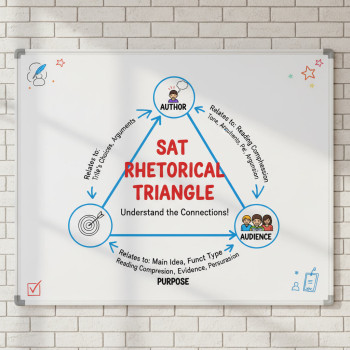Introduction: Two Different Races Same Muscles
You ve seen it before: students who read well in class stumble when the clock starts ticking on a high-stakes exam. AP exams and the Digital SAT both test reading and analysis, but they do it in distinct ways. One asks for deep, sustained synthesis across long passages (and often multiple sources); the other asks for fast, calibrated comprehension across adaptive modules. Understanding the differences and training your brain for each can turn anxiety into confidence.

What Each Test Actually Requires
AP Exams: Depth, Context, and Sustained Focus
AP English Language, AP English Literature, and AP History exams (like AP United States History and AP World History) demand more than quick answers. They evaluate your ability to:
- Read closely and annotate dense or rhetorical texts.
- Synthesize evidence from multiple sources (especially for DBQs and synthesis prompts).
- Manage long-form writing under time pressure crafting organized, evidence-rich essays in response to prompts after reading periods.
Crucially, many AP free-response sections include an official reading period 15 minutes before you begin writing meant for careful analysis, not a frantic skimming session. For example, document-based questions present seven documents to weigh and integrate into a coherent argument. That s endurance: intellectual and temporal.
Digital SAT Reading & Writing: Speed, Strategy, and Adaptive Focus
The modern SAT Reading and Writing section is delivered digitally as two adaptive modules (the total time for Reading and Writing combined is 64 minutes). Each module is shorter about 32 minutes and the test adapts to your performance, sending a differently leveled second module depending on how you did in the first. The key demands are:
- Fast comprehension of medium-length passages and graphs.
- Quick textual evidence selection and grammar/usage editing on the fly.
- Maintaining accuracy under a uniform ticking clock, with fewer opportunities to revisit earlier adaptive blocks in the same way you might on paper.
So where APs reward slow, careful thinking and weaving together multiple sources, the Digital SAT rewards consistent accuracy and efficient time management across compact modules.
How Reading Stamina Plays Out: Side-by-Side
Let s zoom in on specific stamina challenges, because reading stamina is more than just endurance it s pacing, strategy, and mental recovery during a long testing day.
| Feature | AP Lang/Lit/History | Digital SAT Reading & Writing |
|---|---|---|
| Typical Passage Length | Long passages, sometimes multiple texts (synthesis/DBQ) | Shorter to medium passages, single-source focus |
| Time Structure | Longer blocks (ex: 2 hr 15 min free-response with 15-minute reading period; DBQ recommended 60 minutes including reading) | Two 32-minute modules (64 minutes total for RW) with adaptive second module |
| Primary Skill Test | Deep analysis, synthesis, essay writing, historical interpretation | Efficient reading comprehension, evidence selection, grammar and usage |
| Fatigue Risk | High sustained concentration required; later essays can suffer | Medium speed demands can cause errors if you re mentally tired |
| Best Preparation | Practice long timed readings, multi-source syntheses, full practice exams | Timed modular practice, pacing drills, adaptive-question simulations |
Why Training Is Different (and Why That Matters)
Think of your brain as a muscle that adapts specifically to the movement you repeat. If you practice sprint intervals, your speed improves; if you run long distances, your endurance increases. The APs are endurance events for your reading brain complex information must be retained and woven into structured writing. The Digital SAT is more like interval training: repeated bursts of accurate, fast work, with immediate pressure to process and answer.
So, if you prepare one way and expect to ace the other, you ll likely be surprised. A student who can write a brilliant AP essay after a careful reading might still lose points on the SAT if they can t sustain brisk pace across modules. Conversely, a quick reader who thrives on the modular SAT might struggle to hold together arguments across six AP sources.
Practical Training Plans: 8-Week Programs for Both Goals
Below are two sample eight-week plans one focused on building AP-style deep-stamina, the other on sharpening Digital SAT RW speed and accuracy. You can run them in parallel or stagger them depending on your test calendar.
8-Week AP Reading Stamina Plan (Lang/Lit/History)
- Week 1 2: Baseline and Annotation Skills
- Daily: 45 60 minutes of careful reading (poetry, prose, historical documents). Annotate: thesis, evidence, rhetorical moves.
- Weekly: one timed 45 60 minute passage analysis write-up (not full essay yet).
- Week 3 4: Source Integration and Timed Essays
- Daily: practice synthesizing two three short sources into a paragraph with a clear claim + evidence.
- Weekly: one full DBQ or synthesis practice time the reading period for 15 minutes, then write.
- Week 5 6: Endurance and Recovery
- Simulate halves of the AP exam on separate days: morning multiple-choice + afternoon free-response to practice stamina across sessions.
- Practice brief mental resets (1 2 minutes of deep breathing, quick physical stretch) between passages to rebuild focus.
- Week 7 8: Full Practice and Polishing
- Take at least one full-length, timed practice AP exam in test-like conditions.
- Review essays with a rubric or a tutor (this is where Sparkl s personalized tutoring can help 1-on-1 guidance, tailored feedback, and targeted practice to shore up weaknesses).
8-Week Digital SAT Reading & Writing Plan
- Week 1 2: Pacing Foundations
- Daily: timed 20 30 minute reading drills practice finishing passages with correct answers under time pressure.
- Work on question types: inference, central idea, evidence pairing, and grammar.
- Week 3 4: Adaptive Strategy and Module Simulation
- Use practice modules that mimic the two-block structure. Track speed and accuracy for each module separately.
- Drill high-frequency grammar rules and evidence questions in short, focused sessions.
- Week 5 6: Stress Management and Error Analysis
- Do error logs after each practice: what pattern caused mistakes rushed reading, misinterpreted evidence, or grammar gaps?
- Practice quick resets between modules: short mindfulness techniques and a one-minute checklist to re-center.
- Week 7 8: Realistic Test Runs
- Take two full digital SAT practice tests (complete exams) under timed conditions and simulate test technology (laptop, Bluebook demo if available).
- Use personalized tutoring sessions (such as Sparkl s expert tutors) to refine pacing and get AI-driven insights on weak areas.
Daily Habits That Build Both Speed and Depth
Some habits help both types of tests these are high-leverage changes you can adopt today:
- Active reading for 30 60 minutes daily: annotate, summarize a paragraph, and write a one-sentence thesis.
- Timed micro-practices: 20-minute sprint reading sessions for speed and a separate 45 60 minute slow read for depth.
- Vocabulary by context: instead of memorizing lists, learn words through passages and see how authors use them.
- Physical health: consistent sleep, hydration, and short exercise breaks improve mental endurance dramatically.
- Reflection: after every practice, spend 10 minutes reviewing mistakes this cements learning faster than doing more practice without review.
Concrete Example: How to Tackle a Tough AP DBQ vs a Tough SAT Evidence Question
Seeing the methods side-by-side helps you switch mental gears quickly on test day.
AP DBQ Approach (Recommended 60 Minutes Including 15-Minute Reading)
- Reading Period (15 minutes): Skim all documents, annotate author, date, perspective, and a 3-word gist. Jot down potential outside evidence.
- Thesis (5 7 minutes): Create a clear thesis that answers the prompt and signals the argument structure.
- Plan (5 minutes): Map which documents you ll use in each body paragraph and note key evidence quotes or data points.
- Write (30 35 minutes): Follow your outline, integrate documents with analysis, and add one or two outside facts for context.
SAT Evidence Question Approach (Per Passage, Fast and Precise)
- First Read (60 90 seconds): Identify the passage s main idea and the tone/attitude of the author.
- Question Scan: For evidence pair questions, locate lines referenced and confirm how they support the chosen answer don t assume; match text precisely.
- Pace: Aim to spend no more than 5 6 minutes per passage cluster on average; some will be faster, others slower.
Real-World Context: Why Colleges Care and How You Can Leverage Scores
Colleges look at AP scores for credit placement and demonstrated mastery in a subject; they view SAT scores as part of a broader academic snapshot. Both can help, but they show different strengths: APs show deep content mastery and academic perseverance; strong SAT RW performance shows efficient comprehension and strong foundational literacy across disciplines.
That means your strategy can be twofold. If you’re aiming for AP credit and stronger subject credentials, prioritize in-depth practice for APs. If you want to bolster a college application or meet testing requirements, sharpen your SAT RW pacing and accuracy. Many students benefit from doing both thoughtfully training for the particular demands of each exam rather than assuming one preparation style fits all.
How Personalized Help Fits In (Sparkl s Role)
One-size-fits-all study plans rarely work. Personalized tutoring can accelerate progress because it targets the exact combination of gaps and strengths you bring to the table. Sparkl s personalized tutoring offers:
- 1-on-1 guidance that adapts to your reading profile (speed vs depth needs).
- Tailored study plans that sequence AP-style deep reads and SAT-style module drills so your brain builds both endurance and speed.
- Expert tutors who provide structured feedback on essays, annotation habits, and evidence synthesis.
- AI-driven insights that track patterns in mistakes and recommend focused practice to get the most improvement in the least time.
Used sparingly and strategically such as a weekly 1-on-1 review after a full practice test tutors can help you avoid bad habits and make small changes that produce big score improvements.

Common Pitfalls and How to Fix Them
Knowing what to avoid is as important as knowing what to practice.
- Pitfall: Treating all reading practice the same. Fix: Alternate deep reads and pace drills; label each session with its goal.
- Pitfall: Ignoring review after mistakes. Fix: Keep an error log and revisit errors weekly, not just immediately after practice.
- Pitfall: Over-timing early. Fix: Build accuracy first, then shave time off gradually so speed doesn t kill comprehension.
- Pitfall: Skipping full practice tests. Fix: Schedule realistic, proctored or closely simulated full-length tests once every 2 3 weeks to build fatigue resistance.
Checklist for the Week Before Test Day
- Do one light, targeted practice session no new material.
- Get 8 9 hours of sleep for three nights in a row before the test.
- Prepare test-day materials and backup chargers if it s a digital administration.
- Plan brief recovery strategies between sections: a walk, hydration, and a short breathing exercise.
- Trust your pacing plan. Start with what felt most reliable in your final practice tests.
Final Thoughts: Make Your Training Test-Specific and Sustainable
AP exams and the Digital SAT both ask for excellent reading skills, but they ask for them in different ways. Treat your preparation like cross-training: dedicate blocks to speed and accuracy for the SAT, and blocks to depth, synthesis, and long-form expression for APs. Mix recovery and reflection into your plan; mental stamina grows when you practice intentionally and rest appropriately.
And remember: targeted support whether a weekly session with an experienced tutor or a short series of personalized lessons can make the difference between plateauing and improving. If you re balancing schoolwork, extracurriculars, and test prep, a structured partner like Sparkl with 1-on-1 guidance, tailored study plans, expert tutors, and AI-driven insights can shorten the path to stronger performance.
Reading stamina isn t an innate gift; it s a set of habits you build with practice. Start today, train deliberately, and watch how the clock stops being an enemy and starts becoming another tool in your success kit.
Quick Resources to Try This Week
- Pick one AP-style DBQ and time a real 15-minute reading period practice making a one-page annotated plan before you write.
- Do two 32-minute SAT RW module simulations back-to-back on a laptop to simulate adaptive pacing and module transitions.
- Log your errors and share them with a tutor so you can get focused feedback on patterns instead of random practice.
Parting Encouragement
Preparation is personal. Some students gain big wins from a few changes in strategy; others need consistent habits over months. Either way, you re not trying to turn into a different reader you re learning how to show up as your best reader when it counts. With the right practice, pacing, and a little targeted help, both AP and SAT goals are within reach.
Good luck and happy reading.
















No Comments
Leave a comment Cancel